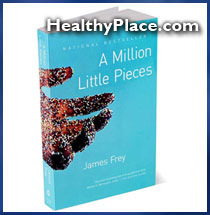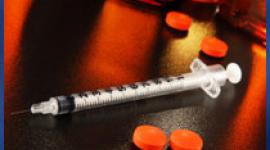James Frey's One True Thing
The Stanton Peele Addiction Website, 21 February, 2006.
Stanton Peele and Amy McCarley
For all his lies and wild exaggerations, nobody seriously disputes that James Frey did successfully overcome alcohol and drug addiction without the help of Alcoholics Anonymous. Too bad his description of why and how he accomplished this - which might help many others - has gotten lost in Frey's spectacular fall from grace.
 James Frey's memoir, A Million Little Pieces, became a best-seller after Oprah Winfrey selected it for her book club in October, 2005. In his memoir Frey, a young man from a prosperous family, reported in gory detail the consequences of overimbibing alcohol for a decade and a three-year crack binge. After what he described as years of police run-ins and blackouts, Frey finally was sent to a treatment center (unnamed in the book, but later revealed to be Hazelden) at age 23 after a fall down a fire escape left him with a broken nose, four teeth missing, and a hole in his cheek.
James Frey's memoir, A Million Little Pieces, became a best-seller after Oprah Winfrey selected it for her book club in October, 2005. In his memoir Frey, a young man from a prosperous family, reported in gory detail the consequences of overimbibing alcohol for a decade and a three-year crack binge. After what he described as years of police run-ins and blackouts, Frey finally was sent to a treatment center (unnamed in the book, but later revealed to be Hazelden) at age 23 after a fall down a fire escape left him with a broken nose, four teeth missing, and a hole in his cheek.
But it turned out that Frey had made up the most exciting incidents of substance abuse in his book, The Smoking Gun website revealed in January of this year. In the primary example of this, Frey claimed to have hit a police officer with his car after smoking crack. Figuring that a big lie is as easy to tell as a little one, Frey added to this fiction that he resisted arrest and fought with police while attempting to incite a riot among bystanders, and to have as a result served three months in a county jail. None of this was remotely true (although Frey was drunk and had a minor mishap with his car, he was extremely polite to a police officer and spent a few hours in custody).
As a result of these and other lies, Oprah publicly stripped Frey of his Book Club status. Lost amid all of the furor about Frey and his dishonesty has been Frey's rejection of his treatment at Hazelden, of its 12 step program, and of AA - from which Hazelden, like virtually every other private hospital program in the U.S., takes its treatment principles. Indeed, from the start of his stardom, little has been made of this aspect of Frey's work, and Frey has seemingly downplayed it - certainly on the Oprah Show.
This article addresses the sources of Frey's deceit - and the ease with which people accepted his tall tales - while reasserting those parts of his book that are true and make the most sense according to psychological principles and addiction research. As one example of his iconoclastic views, Frey declared: "Addiction is not a disease. Not even close. Diseases are destructive medical conditions that human beings do not control. . . . People don't want to accept the responsibility for their own weakness, so they place the blame on something they're not responsible for, like disease or genetics."
Why Did Frey Lie, and Why Did People Accept His Lies?
Frey's raucous memoir is a wild and wooly tale of drinking and drug abuse, exotic sexual and other exploits, death, and physical violence - with Frey as the existential hero at the center of these events. His melee with police and supposed subsequent jail sentence are the primary examples of his fictitious John Wayne persona. Frey depicts himself as a macho character barely capable of restraining - and often giving vent to - his violent impulses.
But why would Oprah, Random House, and 3.5 million readers believe the unending stories of death and violence Frey spins? Frey insinuated himself into a train accident that killed a girl he knew; the girlfriend he was supposed to reunite with after leaving jail hung herself just before he arrived; Frey was originally facing years in prison, but a judge and crime figure he met at Hazelden conspired to reduce the sentence to months in jail - all of these Frey stories are demonstrably false.
Even The Smoking Gun did not initially question Frey's accuracy, since they are used to people hiding their police run-ins and prison records. Rather, they were simply trying to discover a mug shot. The uncovering of Frey's string of falsehoods was thus inadvertent. TSG now can move on to Europe to investigate Frey's story that he feared he murdered a priest who tried to grope him by kicking him repeatedly in the groin (homophobic fantasies, anyone?).
Frey addressed this testosterone-fueled caricature he created for himself in an apologia at the Random House Web site. "I made alterations in my portrayal of myself, most of which portrayed me in ways that make me tougher and more daring and more aggressive than in reality I was, or am." The policeman questioned by The Smoking Gun who arrested a polite Frey might be closer to the mark: "He thinks he's a bit of a desperado. . . . making a bunch of crap up." Frey is typical of many privileged young men who dream about being bad asses.
But Frey had other reasons to lie. Drug degradation sells. People want to hear about the horrible things people do while high on crack and drunk. Given this, Frey might well have concluded that amplifying his war stories would enhance their appeal.
Frey had a chance to observe this process close up. He describes a speech given by a former patient, a rock star, to Hazelden inmates. The man detailed ridiculous levels of drug and alcohol use (a $4,000-$5,000 daily drug habit, "five bottles of strong liquor" a night, 40 valium to go to sleep). The lies outraged Frey: "The truth is all that matters. This is fucking heresy."
Indeed, Frey could regularly observe the embellishment of lurid life stories at his various group meetings. Accuracy is not a requirement at these confessionals - vividness is. Many or most AA members undoubtedly exaggerate their exploits in their efforts to upstage one another. After all, the only thing worse than being an addicted sadsack is being a dull addicted sadsack.
Of course, Hazelden staff didn't call the rock star on his lies. In their view, such outlandish claims serve to instruct gullible patients about how their use can escalate beyond their wildest imagination. One sidelight in all of this is how important it is to question public and private testimony about substance abuse degradation. Our cultural ethos supports such horror stories - at Hazelden and elsewhere, you simply can't say enough bad about drugs.
To review the history of ridiculous claims about drugs (and, alcohol, for example during the Temperance period) is beyond the scope of this article. However, we can briefly recall here that, in January of 1968, Norman M. Yoder, commissioner of the Pennsylvania Office of the Blind, claimed that six college students blinded themselves by staring at the sun while tripping on LSD. The story was widely reported in the legitimate news media, although it was a fabrication. In 1980, Washington Post reporter Janet Cooke wrote about an 8-year-old addict who had been taking heroin since he was five, for which she won a Pulitzer Prize. This story too was made up.
Although Mr. Yoder and Ms. Cooke lost their jobs because their efforts at fiction did not correspond with their job descriptions, this is not always the outcome for those who inaccurately report about drugs. For example, in August 1994, the New York Times ran a front page story about an epidemic of overdose due to China Cat, "a blend of heroin so pure it promised a perfect high, but instead killed 13 people in five days." A few days later, buried deep in the newspaper, the Times reported that much of the story was wrong. Two of the men had died of natural causes, and another four also had no heroin in their systems. The other seven had taken other drugs in combination with heroin.
No Times reporters or editors were fired in this case for swallowing whole an urban legend. After all, the thinking goes, their excessiveness was in the service of a good cause - making drug use look even more dangerous than it is. But, as Frey's case demonstrates, lies, misrepresentations, and inaccuracies have negative consequences. For example, the Times' inaccuracies disguise that it is more dangerous - leading to more deaths - to combine drugs than it is to take a strong dose of pure heroin.
How About Frey's Claims About His Treatment?
Random House corroborated Frey's book by producing two fellow Hazelden inmates - one the judge Frey described. Both, according to the New York Times, supported Frey's "overall description" of his treatment experience against objections by Hazelden staff. Predictably, the two patients did say that Frey exaggerated the confrontations among inmates and staff. For his part, according to the Times, "Frey has admitted to embellishing his past, but has maintained that his experiences in drug rehabilitation were real."
Frey failed to gain traction at Hazelden from the outset. He was repeatedly lectured that "the only way . . . you'll be able to control your addictions is by working the Twelve Steps." For Frey, this indicates he was headed for failure directly out of the blocks: "People like you keep saying it's the only way, so I'm thinking that I might as well just put myself out of my misery now and save myself and my family the pain of the future."
As a result of his feelings about religion, Frey is not favorably oriented towards the 12-step philosophy with which Hazelden indoctrinates its "patients." "God," "Him," or a "higher power," is mentioned in half of the steps. The third step requires patients to declare they have "Made a decision to turn our will and our lives over to the care of God as we understood Him." AA acolytes try to ignore the religiosity of the steps by claiming they are "spiritual." This doesn't wash for Frey: "From where I sit, all religion and spiritual thought are the same thing." And, for Frey, belief or disbelief in God had nothing to do with quitting an addiction.
Frey's objections to the Hazelden treatment process are consistent with the personal philosophy he expresses in his book. Frey portrays himself as a serious atheist and a follower of Taoism. Why would he lie about not believing in God? "The whole thing is based on a belief in God. I don't have it and I never will." Perhaps The Smoking Gun will produce witnesses who have seen Frey praying intensely in church - but we don't think so.
Meanwhile, every appeals court which has heard the issue has declared that the 12 steps are religious. As a result, coercion into AA and treatment by courts, prisons, and government agencies violates the First Amendment's separation of church and state. This ruling is consistently violated around the United States .
Frey's feeling that it wasn't right for him to be forced to follow such religious preaching is thus based on sound legal principles. Moreover, it is a violation of patients' rights to compel them to adopt beliefs they don't hold, or actively disagree with. A violation, that is, in anything other than American substance abuse treatment. Furthermore, psychological research indicates that people's motivation to change is enhanced when a therapy is consistent with their values. On the other hand, the effort to change people's behavior at a low point by attacking their feelings and beliefs is kicking people when they are down, and is profoundly counterproductive. Frey understands this truth: "when someone needs help most, you deny it to them because they believe in something different than you or need a different kind of help than what you think is right."
New recruits who balk at AA's teaching are often derided, as was Frey, with taunts that they are welcome to maintain their beliefs, to keep making decisions for themselves, and to continue on their current paths - which, they are mocked, are working so well for them. The Hazelden process encourages addicts to plummet into despair - like a religious sinner - in the view that this is the best way to encourage change. Instead, deriding already demoralized people undermines their self-confidence at precisely the moment they need it the most, and can cause permanent damage. Perhaps Frey's megalomaniac fantasies were his effort to counteract Hazelden's assaults on his self-esteem.
(Frey reports showing up at Hazelden disoriented and requiring immediate oral surgery, which he claims he underwent without anesthesia, another disputed point in his book. Although he has acknowledged making up stories of his violent actions, crimes, and imprisonment, Frey partially defends his description of unanaesthetized surgery: "I wrote that passage from memory, and have medical records that seem to support it. . . . [although] my memory may be flawed." In fact, we have each observed abstinence programs and AA groups that insist participants take no pain-killing medications, and we believe it possible Frey was operated on with only a topical anesthetic.)
All of this explains why, contrary to Hazelden's and AA's self-promoting myths and popular opinion, traditional treatment and AA are not particularly successful ways to overcome addictions. For example, AA's own surveys reveal that only 5 percent of initial attendees at AA meetings continue with AA for as long as a year. (This is not a guarantee that they've actually quit drinking - or even that they've cut back.)
Research on alcoholism treatment finds 12-step treatment and AA to be ineffective compared with teaching addicts coping skills and eliciting their internal motivations to quit (called "motivational enhancement"). Counselors at Hazelden actually used their low success rate to convince Frey to accept the 12 steps: "AA and the Twelve Step are the only real options. . . .Fifteen percent of those who try them are sober for more than a year. [This figure is so low because addiction] is an incurable illness. . . . there's nothing else you can do."
Frey is repeatedly lectured at Hazelden, "addiction is a disease. . . . a chronic and progressive disease. . . .the inability to control and the lack of choice is but a symptom of the disease." But Frey rejects this idea on such sound grounds as that, with real diseases, people "do not choose when to have them, they do not choose when to get rid of them." Frey instead asserts that every choice to use is a decision: "Do I or don't I. Am I going to take or am I not going to take. Am I going to be a pathetic dumbshit addict and continue to waste my life or am I going to say no and try to stay sober and be a decent person." Actually, isn't treatment at Hazelden a way of convincing people to control themselves?
Not surprisingly, Frey simply despises AA. When told that the only alternative to AA is relapse and death, Frey declares: "I'd rather have that than spend my life in church basements listening to people whine and bitch and complain. . . . It is the replacement of one addiction with another." Frey expresses objections that many - a silent majority - of alcoholics and addicts feel towards AA and its steps. This is why so many people desert AA and fail at treatment programs. These people simply don't feel that the best way to change is to decide that they are powerless, turn themselves over to God, and participate in group confessionals.
Such people, like Frey, would obviously do better in therapy programs that did not require them to spend most of their emotional energy struggling to accept precepts that contradict their own instincts about what will make them better. Disagreeing with the 12 steps should not disqualify people from receiving treatment and support in overcoming an addiction. Atheists deserve help too! As it is, objections like Frey's to treatment are not only ignored - they are labeled "denial," a symptom of the disease that is to be overcome.
Why Do People Ignore Frey's Anti-AA, Anti-Disease, and Anti-Treatment Message?
Most people are so prejudiced in favor of - or just don't recognize any alternative to - 12 steps and AA, they don't hear Frey's negative attitudes towards this approach. AA is the most successful combination of a social movement/public relations organization in twentieth century America . It has cornered the addiction treatment market - indeed, its 12 steps have been applied to virtually every unhealthy habit Americans can have. On top of this, it may be that Frey laid on his sensationalistic "accounts" of debauchery and mayhem so thick that most readers were distracted from his critique of 12-step therapy.
Furthermore, Frey began to downplay his anti-AA and anti-treatment philosophy. When Frey appeared on John Stossel's anti-treatment special on ABC ("Help Me, I Can't Help Myself") with one of us (SP) in April 2003, he ridiculed the 12 steps. But when Frey appeared on Oprah after being selected for her book club in the fall of 2005, he seemed to change his tune. Viewers were unable to discern that he differed from the typical recovering addict. As one viewer we know reported, "When I saw him on Oprah on the original book club appearance, I figured he was an AA member because he was shown doing things like going around apologizing to people from his drunk days, which I thought was straight from the AA playbook."
The Smoking Gun describes how Frey "traveled to a Minnesota clinic and gave an on-camera pep talk to Sandie, a viewer who checked herself into rehab after learning about Frey's book . . . . 'If I can do it, you can do it,' Frey told her." Thus Frey helped television to prod people to enroll in the kind of treatment he rejected, undercutting the mission he outlined at the Random House web site:
I survived my addictions. I lived through them and past them. I did not do it the way most are told is the only way. I did not use God or a Higher Power or a Twelve Step Group of any kind. I used my will, my heart, my friends, my family. Most people who use God or a Higher Power or a Twelve Step Group fail. There is another way that might work. It worked for me. I want to share it. I hope it works for others.
Frey's Greatest Failure
There is one other reason James Frey's views about addiction and treatment have not had a big impact, despite his book's overwhelming success. He doesn't believe them totally himself. After all, Frey is a guy who wasted a lot of time taking drugs and drinking, thereby violating his own values of self-reliance and wanting to be a contributing member of society. Thus the two parts of Frey's book - the outlandish claims about his drunken and drugged behavior, and his fearlessness in turning to himself for a cure - are at war with each other.
We can view Frey's addictiveness as really his own acceptance in a part of him of the AA message he felt that he had to reject. How else are we to interpret Frey's various descriptions in the book of "the great and terrible rock" (crack):
Give me more please give me more I want need have to have more. I'll give my life heart soul money future everything please give me more. I want need have to have more. Give me more and I'll give you everything. Give me more and I'll do whatever you want.
In order to justify his own past behavior, Frey simply restates the disease prophecy: "I was weak and pathetic and I couldn't control myself." But, as he embarked on his own self-cure through the unique approach of exposing himself to the temptation of drugs and alcohol without using, it turned out at some point he did have the motivation to control himself. "I have a decision to make. It is a simple decision. It has nothing to do with God or Twelve of anything other than twelve beats of my heart. . . . Yes or no."
That the crucial, original part of Frey's book - the heartfelt and accurate part - has not been heard indicates how difficult it is to break the AA hegemony in the United States . The worst thing about AA - and the experience Frey underwent at Hazelden - is its denial of the existence of valid alternative paths to ending addiction. We have reached an impasse until more people who end their addictions quietly, on their own terms, come forward to reveal their personal experiences. But, in order to do that these silent veterans of addiction would have to violate what likely led them to their own brand of recovery: they value their privacy and they want to develop a meaningful life separate from a therapy program. Such people do not feel an urge to proselytize.
Frey's moral failings have undercut his ability to promote self-cure of addiction. It will take a stronger person than Frey - perhaps many such people - to fight the monolithic American treatment system. Frey has lost the claims of authority and authenticity to assert what he really believes - that America 's ineffective drug and alcohol treatment, as well as its cultural wellsprings, are limited by religious beliefs and drug bogeymen.
next: Love and Addiction - 2. What Addiction Is, and What It Has to Do with Drugs
~ all Stanton Peele articles
~ addictions library articles
~ all addictions articles
APA Reference
Staff, H.
(2008, December 21). James Frey's One True Thing, HealthyPlace. Retrieved
on 2025, December 23 from https://www.healthyplace.com/addictions/articles/james-freys-one-true-thing



